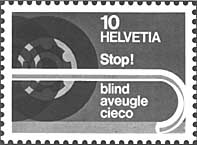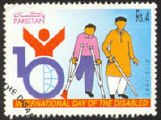| White
Canes
(Guide dog, Braille and white stick are the three most common items used to symbolize blindness on stamps.) |
||||||||||
For centuries, the "cane"
was used merely as a tool for travel and it was not until the twentieth
century that the cane, as we know it today, was promoted for use by the
blind as a symbol to alert others to the fact that an individual was blind.
This new role for the white cane had its origins in the decades between
the two World Wars, beginning in Europe and then spreading to North America.
James Biggs of Bristol claimed to have invented the white cane in 1921.
After an accident claimed his sight, the artist had to readjust to his
environment. Feeling threatened by increased motor vehicle traffic around
his home, Biggs decided to paint his walking stick white to make himself
more visible to motorists.
It was not however until ten years later the white cane established its presence in society. In February 1931, Guilly d'Herbemont launched a scheme for a national white stick movement for blind people in France. The campaign was reported in British newspapers leading to a similar scheme being sponsored by rotary clubs throughout the United Kingdom. In May 1931 the BBC suggested in its radio broadcasts that blind individuals might be provided with a white stick, which would become universally recognized as a symbol indicating that somebody was blind or visually impaired..
In North America the introduction of the white cane has been attributed
to the Lion's Clubs International. In 1930, a Lion's Club member watched
as a blind man attempted to make his way across a busy street using a black
cane. With the realization that the black cane was barely visible to motorists,
the Lion's Club decided to paint the cane white to increase its visibility
to oncoming motorists. In 1931, the Lion's Club International began a national
program promoting the use of white canes for persons who are blind Throughout
the 1920s and 1930s, blind persons had walked with their canes held diagonally
in a fixed position, and the role of the white cane took on a symbolic
role as an identifier
- History of white cane from American Society of the Blind - |
||||||||||
| More ophthalmic stamps |




